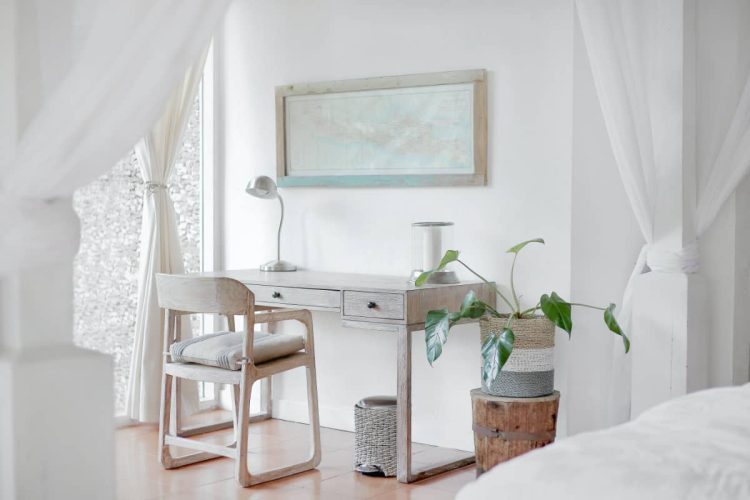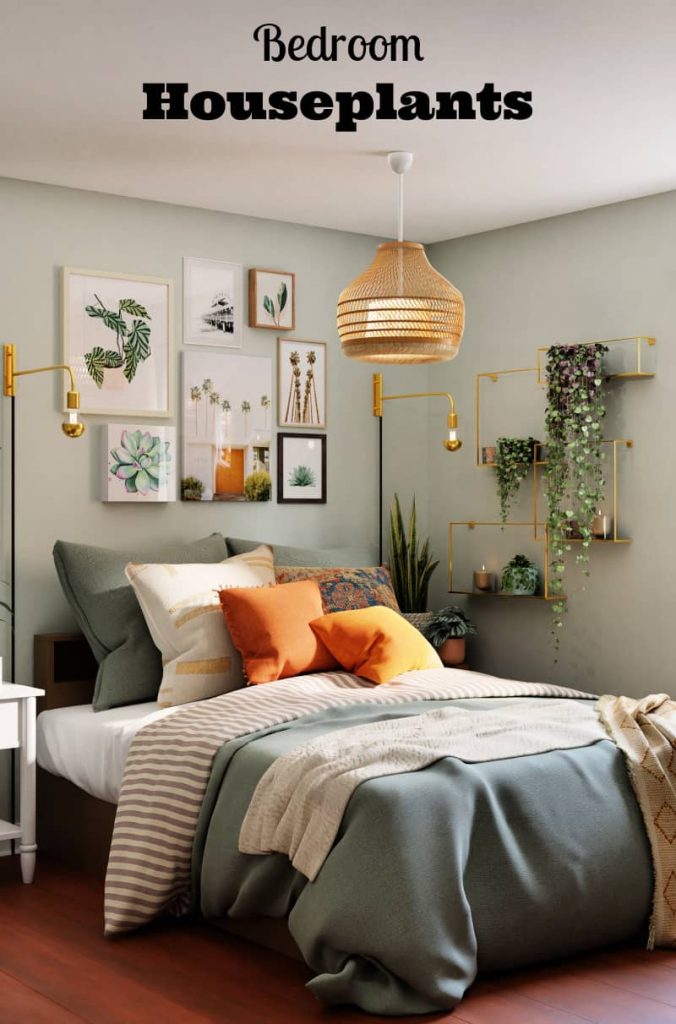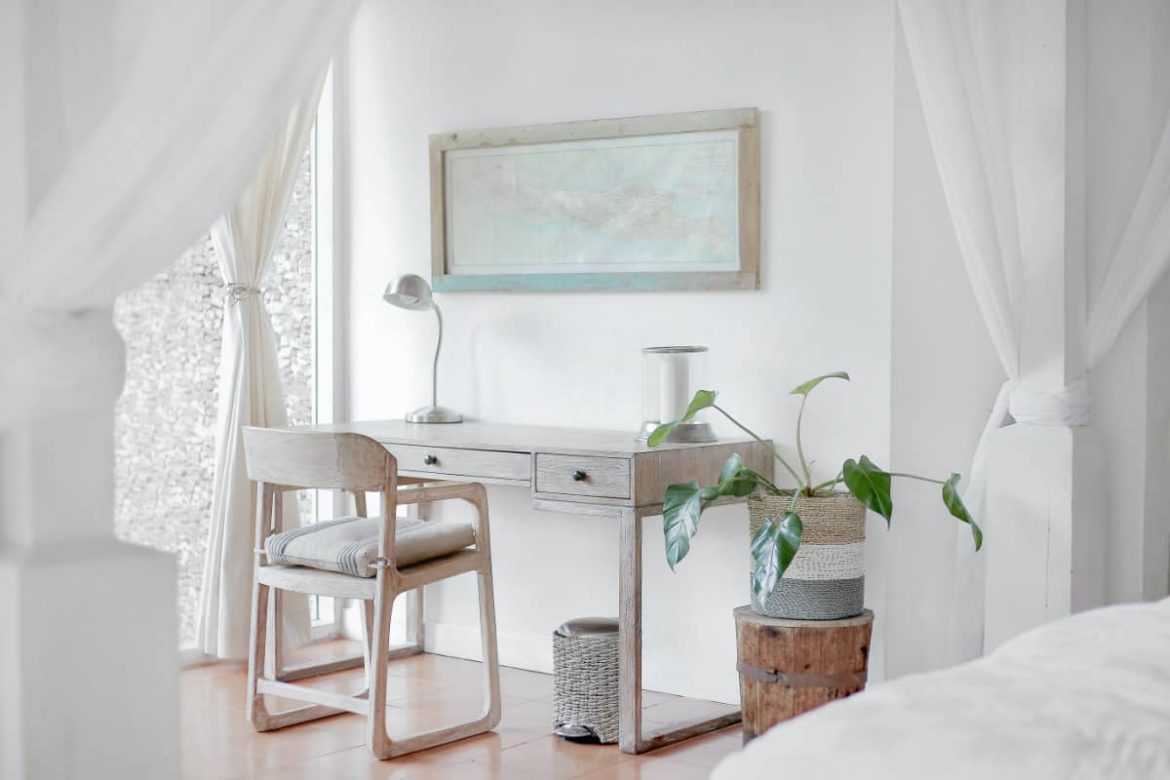A good night’s sleep is how our body restores and resets. Creating an atmosphere that promotes quality rest requires a supportive mattress, light and noise-blocking elements, and a cool ambient temperature. However, your decor can also affect how well you rest. Plants have long been used in interior design for their mood-boosting properties. Some house plants can even help induce a sense of calm and relaxation. Here are some of the most effective sleep-inducing plants for the bedroom.
10 Plants For Your Bedroom
These all make good plants for the bedroom. The first nine bedroom houseplants on this list are chosen for their sleep-inducing properties. The final suggestion is just because this type of indoor plant is so visually appealing and mood setting for the bedroom.

Peace Lily
The Peace Lily is a popular indoor plant known for its large, glossy leaves and delicate white flowers. The scent of the peace lily is relatively subtle, and some people may not detect a strong aroma from the plant.
Peace lilies are known for their air-purifying properties. They are capable of removing toxins such as formaldehyde, benzene, and carbon monoxide from the air. They are also known to be effective at increasing humidity in a room, which can be beneficial for people suffering from dry skin or respiratory issues like sleep apnea.
Place your Peace Lily in a location with bright, indirect light. They prefer high humidity, so it’s a good idea to mist the leaves regularly or place the pot on a tray of wet pebbles. Keep the soil consistently moist but not waterlogged, as this plant is prone to root rot. They also prefer to be fertilized regularly to encourage healthy growth.
Orchid
Orchids are said to have a calming effect on the mind and promote feelings of tranquility and peace. Orchids are known for their delicate blooms and exotic appearance, making them a popular choice when scheduling a flower delivery for a home oasis. When orchids bloom, their blooms last for much longer than most flowers- usually around 6 weeks!
Orchids are relatively low maintenance but have unique care requirements to thrive and grow. Most orchids require bright, indirect sunlight, thriving near a West or North-facing window. They have minimal watering requirements, with experts recommending placing 2-3 ice cubes on the soil each week. This allows a slow release of water to prevent root rot.
Lavender
Lavender is well known for its soothing scent and therapeutic properties. It’s one of the most popular scents for reducing stress and anxiety and a bestseller in essential oils.
Lavender can be challenging to keep in a pot, as it’s a Mediterranean plant that thrives in temperate. Place this plant in a well-lit East or South-facing window, and ensure your lavender has plenty of humidity. It also requires regular pruning and over-wintering.
If keeping live lavender is too much work, you can also dry fresh sprigs and enjoy the scent without effort.
Peppermint
People often overlook the option of growing fresh herbs as decorative plants. Peppermint is easy to grow and is known for its therapeutic benefits.
This perennial herb boasts a refreshing and invigorating aroma. The peppermint aroma is said to have several benefits, including improved cognition, headache relief, improved respiratory function, and relieving stress.
Plant your peppermint (or start from seed) in loose, well-draining soil. Water regularly, letting the water dry completely in between soaks. Place in a sunny window and trim back regularly to promote bushiness. You can use cuttings in teas and culinary dishes.
Lemon Balm
Lemon balm is another herb with a minty lemon aroma and is known for its calming and soothing properties. Some potential benefits of lemon balm aroma include reducing stress and anxiety, improving sleep, and promoting a sense of calm.
To grow lemon balm in a pot, you’ll need a container with drainage holes, a well-draining potting mix, and a sunny location. You can trim this herb back regularly to promote business and use the cuttings in Asian cuisine and tea.

Snake Plant
The Snake Plants are popular, low-maintenance indoor plants known for their tall, upright leaves that resemble those of a snake. The plant is known for its ability to purify the air by absorbing toxins such as formaldehyde, benzene, and carbon monoxide.
One of the reasons why the snake plant is a good plant for the bedroom is that it releases oxygen at night, which can help improve air quality and promote better sleep. The snake plant is also known for its ability to tolerate low light conditions and low humidity, making it a great choice for a dim bedroom.
Caring for a snake plant is relatively easy. They prefer well-draining soil and can tolerate a wide range of temperatures with minimal sunlight. They prefer to be watered sparingly, allowing the soil to dry out slightly between waterings.
Aloe Vera
Aloe vera is known for its healing properties when the inner gel is applied to cuts and burns. It’s a popular addition to many cosmetics for its positive impact on the skin.
What many people don’t realize is that aloe also helps purify the air, promoting easier breathability and rest. Aloe is a low-maintenance succulent that’s beginner friendly.
Plant your aloe in well-draining soil and place it in a sunny window. Let the soil dry completely between waterings — it’s better to underwater than overwater these desert plants.
Well-tended aloe will produce pups, which can be propagated and gifted to help friends and family rest easy.
Jasmine
The jasmine flower aroma is often described as sweet and heady or potent. It’s believed to help reduce stress, induce calm, and improve one’s mood when inhaled.
When selecting a jasmine plant to grow in your room, choose a dwarf variety that’s more suited to an indoor environment. Plant in well-draining soil and place in bright, indirect sunlight for best results. You can also propagate your jasmine plant by taking cuttings prior to the active season in the spring.
Gardenia
Gardenia is another stunning flower known for its sweet and soothing scent, which is often described as perfumy and heady with a delicate spicy undertone. The aroma is said to induce relaxation and promote stress relief.
Growing Gardenia in a pot is possible, but it can be a bit challenging. Gardenias prefer a warm and humid environment, and they need well-draining soil that is high in acidity. You’ll need a container with drainage holes and a well-draining potting mix specifically formulated for acid-loving plants. Gardenias also prefer a location with bright, indirect light. Keep the soil consistently moist but not waterlogged.

Palm House Plants
There are several types of tropical palm plants that make good indoor plants. They are all stunning to look at and help you feel congruent with nature. Most are large for houseplants so they really impact the look of a room and help it feel like a relaxing oasis.
Most palms will do well in full sun to part shade. They need soil that drains well and tend to like moderately moist soil.
Final Thoughts
It’s important to remember that plants aren’t a replacement for medical treatments when dealing with sleep disorders. However, adding these plants to your room can help you create a relaxing environment that promotes rest. What do think will be the best plants for your bedroom? Share your photos with us on social media @familyfocusblog!
Related Posts:

